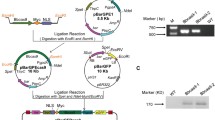Abstract
Targeted gene replacement via homologous recombination (HR) is a conventional approach for the analysis of gene function. However, this event is rare in Beauveria bassiana, which hampers efficient functional analysis in this widely used entomopathogenic fungus. To improve homologous recombination frequency in B. bassiana, we investigated the effect of the ratio of homologous sequence to non-homologous sequence (HS/NHS) in gene disruption cassette upon the HR frequency by two gene loci BbNtl and BbThi, using the herpes simplex virus thymidine kinase as a negative selectable marker against ectopic transformants. Our data revealed that an increase of the ratio of HS/NHS achieved by either extending homologous sequence or decreasing non-homologous sequence could improve HR frequency in B. bassiana. We determined empirically that (1) at least 700 bp of homology to both sides of a target gene was needed to get a reasonable number of disruptants, e.g., 6.7‰ to 13.3‰ in B. bassiana. (2) When the ratio of HS/NHS was above 0.8, an acceptable HR frequency could be achieved for gene replacement in B. bassiana, while when the ratio was below 0.3, few gene disrupted mutants were obtained.



Similar content being viewed by others
References
Bird D, Bradshaw R (1997) Gene targeting is locus dependent in the filamentous fungus Aspergillus nidulans. Mol Gen Genet 255:219–225
Charnley AK (2003) Fungal pathogens of insects: cuticle degrading enzymes and toxins. Adv Bot Res 40:241–321
Covert SF, Kapoor P, Lee M, Briley A, Nairn CJ (2001) Agrobacterium-mediated transformation of Fusarium circinatum. Mycol Res 105:259–264
Fang WG, Zhang YJ, Yang XY, Zheng XL, Duan H, Li Y, Pei Y (2004) Agrobacterium tumefaciens-mediated transformation of Beauveria bassiana using an herbicide resistance gene as a selection marker. J Invertebr Pathol 85:18–24
Fang WG, Scully LR, Zhang L, Pei Y, Bidochka MJ (2008) Implication of a regulator of G protein signaling (BbRGS1) in conidiation and conidial thermotolerance of the insect pathogenic fungus Beauveria bassiana. FEMS Microbiol Lett 279:146–156
Gardiner DM, Howlett BJ (2004) Negative selection using thymidine kinase increases the efficiency of recovery of transformants with targeted genes in the filamentous fungus Leptosphaeria maculans. Curr Genet 45:249–255
Gray M, Honigberg SM (2001) Effect of chromosomal locus, GC content and length of homology on PCR-mediated targeted gene replacement in Saccharomyces. Nucleic Acids Res 29:5156–5162
Hajek A, St Leger RJ (1994) Interactions between fungal pathogens and insect hosts. Annu Rev Entomol 39:293–322
Jin K, Zhang YJ, Luo ZB, Xiao YH, Fan YH, Wu D, Pei Y (2008) An improved method for Beauveria bassiana transformation using phosphinothricin acetlytransferase and green fluorescent protein fusion gene as a selectable and visible marker. Biotechnol Lett 30:1379–1383
Khang CH, Park SY, Lee YH, Kang S (2005) A dual selection based, targeted gene replacement tool for Magnaporthe grisea and Fusarium oxysporum. Fungal Genet Biol 42:483–492
Krappmann S (2007) Gene targeting in filamentous fungi: the benefits of impaired repair. Fungal Biol Rev 21:25–29
Michielse CB, Arentshorst M, Ram AFJ, van den Hondel CAMJJ (2005a) Agrobacterium-mediated transformation leads to improved gene replacement efficiency in Aspergillus awamori. Fungal Genet Biol 42:9–19
Michielse CB, Hooykaas PJ, van den Hondel CAMJJ, Ram AF (2005b) Agrobacterium-mediated transformation as a tool for functional genomics in fungi. Curr Genet 48:1–17
Mullins ED, Kang S (2001) Transformation: a tool for studying fungal pathogens of plants. Cell Mol Life Sci 58:2043–2052
Nelson RT, Pryor BA, Lodge JK (2003) Sequence length required for homologous recombination in Cryptococcus neoformans. Fungal Genet Biol 38:1–9
Ninomiya Y, Suzuki K, Ishii C, Inoue H (2004) Highly efficient gene replacements in Neurospora strains deficient for non-homologous end joining. Proc Natl Acad Sci U S A 101:12248–12253
Praekelt UM, Byrne KL, Meacock PA (1994) Regulation of THI4 (MOL1), a thiamine-biosynthetic gene of Saccharomyces cerevisiae. Yeast 10:481–490
Reader U, Broda P (1985) Rapid preparation of DNA from filamentous fungi. Lett Appl Microbiol 1:17–20
Sambrook J, Russell DW (2001) Molecular cloning: a laboratory manual, 3rd edn. Cold Spring Harbor Laboratory Press, Cold Spring Harbor, NY
St Leger RJ, Joshi L, Bidochka MJ, Roberts DW (1996) Construction of an improved mycoinsecticide overexpressing a toxic protease. Proc Natl Acad Sci U S A 93:6349–6354
van Attikum H, Hooykaas PJJ (2003) Genetic requirements for the targeted integration of Agrobacterium T-DNA in Saccharomyces cerevisiae. Nucleic Acid Res 31:826–832
Wen-jun S, Forde BG (1989) Efficient transformation of Agrobacterium spp. by high voltage electroporation. Nucleic Acid Res 17:8385–8389
Acknowledgments
We thank Dr. Mark Guiltinan, Pennsylvania State University, for provision of Agrobacterium tumefaciens strain AGL-1 and Dr. Barbara Howlett, Melbourne University, for provision of the plasmid pPZPtk8.10. This work was supported by China National Basic Research and Development Program grant (2003CB114203) and Hi-Tech Research and Development Program of China (2006AA10A212).
Author information
Authors and Affiliations
Corresponding author
Rights and permissions
About this article
Cite this article
Ma, JC., Zhou, Q., Zhou, YH. et al. The size and ratio of homologous sequence to non-homologous sequence in gene disruption cassette influences the gene targeting efficiency in Beauveria bassiana . Appl Microbiol Biotechnol 82, 891–898 (2009). https://doi.org/10.1007/s00253-008-1844-0
Received:
Revised:
Accepted:
Published:
Issue Date:
DOI: https://doi.org/10.1007/s00253-008-1844-0




